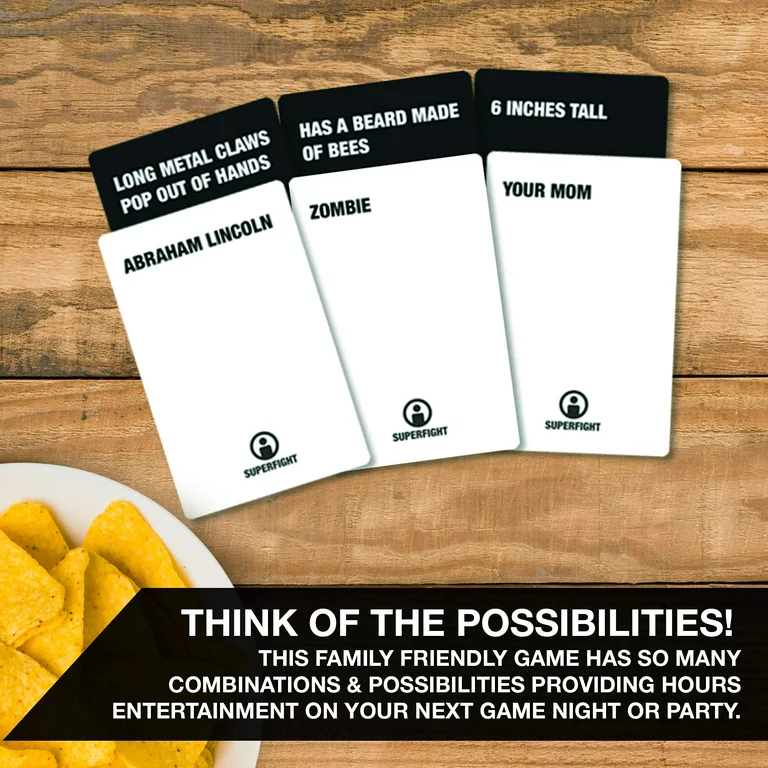
Introduction to Superfight and Yap Battle
“Superfight,” an original card game by Jack Dire, blends humor and absurdity to captivate players and spark conversations. It involves players drawing cards to create fighters with bizarre abilities and traits, then debating who would win in a hypothetical fight. This setup leads to unpredictable and often hilarious outcomes, making Superfight ideal for party settings or casual gatherings. Marketed to those 12 and older, it appeals to fans of bright, creative debates. The game’s simplicity and the endless possibilities of character and scenario combinations ensure no two games are alike. During a recent virtual session using a card generator, I played Superfight with friends, which tested our wit and creative argumentation as we crafted compelling, often ludicrous victory scenarios. This experience will serve as a useful reference for developing our card game project, “Yap Battle.” While I haven’t yet played “Yap Battle,” analyzing its proposed mechanics, dynamics, and aesthetics offers valuable insights into potential game design and player interactions.
Formal Elements: Mechanics, Dynamics, and Aesthetics
Applying the MDA framework—Mechanics, Dynamics, and Aesthetics, we can analyze these games to understand their construction and the effect on the players. “Superfight” uses players drawing cards to make weird superheroes that fight each other in participant-led debates, evoking fun and competition. In contrast, “Yap Battle,” while also leveraging debates, introduces Viewer Coercion cards. These unique cards are a pivotal element of gameplay, adding a strategic twist where players must cleverly insert specific words or phrases from their Viewer Coercion cards into their debate arguments. This mechanic not only challenges players’ linguistic creativity but also enhances the competitive edge by rewarding subtlety and clever wordplay. Requiring the players to effectively use particular words in arguments, poses an extra layer of complexity and strategy over the humor and debate. This integration demands a higher level of engagement and strategic thinking, as players must balance the goal of winning the debate with the task of integrating specific words, thus enriching the overall depth and enjoyment of the game.
Central Argument
My latest play session with “Superfight” highlighted what makes it so appealing in the first place: impromptu and frequently funny arguments. Word integration, a strategic component that “Yap Battle” adds to the formula, requires participants to do more than just dispute; they must also deftly incorporate particular words into their stories. By requiring not only persuasive abilities but also cunning and nuance in communication, this extra layer has the ability to deepen engagement.
Comparative Analysis
- Mechanics: In “Superfight,” the mechanics are fairly straightforward, with players drawing cards that randomly determine their debate characters. “Yap Battle” builds on this by having players draw not only debate topics but also Viewer Coercion cards, adding an element of linguistic strategy to the humorous debates.
- Dynamics: “Superfight” can lead to unbalanced but entertaining matches, largely dependent on the luck of the draw. “Yap Battle” aims to balance this randomness with strategic decision-making, where players must think carefully about how to incorporate their Viewer Coercion words effectively.
- Aesthetics: Both games cater to the aesthetic of humor. “Superfight” focuses on the joy of the absurd, while “Yap Battle” adds a layer of intellectual engagement by rewarding clever wordplay, thus aiming to satisfy both the desire for humor and intellectual challenge.
Integration of Course Concepts
When I think back on my experience playing “Superfight” and take the theoretical foundations from “Theory of Fun for Game Design” into consideration, it becomes clear that “Superfight” is excellent at providing impromptu fun. But “Yap Battle,” with its extra gameplay elements, might more effectively capture the aesthetic of exploration and difficulty, since players navigate linguistic obstacles in addition to debating.
Evidence from Gameplay Experience
One particularly memorable argument that I took part in during the “Superfight” session was “a kindergarten class where their bottom half is your mom and there are 50 of them” versus “a zombie that has to pee really bad and has dog ears.” Despite being ridiculous, this clash generated an interesting and memorable discussion. That demonstrated how well the game fosters innovation and camaraderie. As for “Yap Battle,” I think it will create a similar vibe, but it will also provide a satisfying challenge as players try to sneak in certain terms, which will make the game more creative and competitive.
Conclusion
While both “Superfight” and “Yap Battle” aim to produce interesting argument scenarios, “Yap Battle” claims to include a strategic component that will up the ante on involvement and cerebral stimulation. As we approach playtesting “Yap Battle,” I am confident in the game’s ability to enhance the genre by fusing linguistic and strategic acuity with rhetorical skill. “Yap Battle” intends to enhance the argument game genre as it progresses from idea to playtesting by adding gaming mechanisms that prioritize linguistic and strategic aptitude in addition to rhetorical talent, possibly providing a more immersive, deeper player experience.



